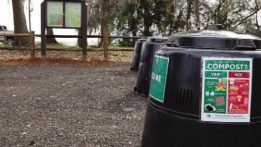 Florida receives the fourth most rainfall annually of all the states, creating a need for large-scale drainage and water management, especially in urban areas like Tallahassee. On your property, the first stage of this water management begins with your gutter. Due to the sheer volume of water that crosses your roof on an annual basis, it’s crucial that your gutter is being actively maintained, as a faulty gutter can be costly, leading to long-term damage to your home. This info will help you understand the type of gutter you have and how to keep your gutter in great working order!
Florida receives the fourth most rainfall annually of all the states, creating a need for large-scale drainage and water management, especially in urban areas like Tallahassee. On your property, the first stage of this water management begins with your gutter. Due to the sheer volume of water that crosses your roof on an annual basis, it’s crucial that your gutter is being actively maintained, as a faulty gutter can be costly, leading to long-term damage to your home. This info will help you understand the type of gutter you have and how to keep your gutter in great working order!
Styles
The three most common types of gutters on homes today are half-round, K-style, and fascia gutters. Each style presents its own benefits and challenges associated with maintenance. So, it’s important that you can identify the type that you have installed on your home to make cleaning and repairs easier.
Half-round:
 This style of gutter is traditional and is featured on many older homes due to how effectively it transports water. The rounded sides make installation a little more involved, often requiring the use of brackets to mount them onto the side of a house. Another option is seamless half-round gutters, which are installed in full pieces rather than segments aside from the corners which still need to be pieced together. Seamless half-round gutters are great if you want a modern look with the functionality that a half-round gutter provides. While they can be more prone to clogs, the design of half-round gutters lends itself to less frequent maintenance for issues such as leaks or corrosion. Often on historic homes, this type of gutter can also be beneficial for homeowners that live in climates where heavy rainfall and/or snow are common.
This style of gutter is traditional and is featured on many older homes due to how effectively it transports water. The rounded sides make installation a little more involved, often requiring the use of brackets to mount them onto the side of a house. Another option is seamless half-round gutters, which are installed in full pieces rather than segments aside from the corners which still need to be pieced together. Seamless half-round gutters are great if you want a modern look with the functionality that a half-round gutter provides. While they can be more prone to clogs, the design of half-round gutters lends itself to less frequent maintenance for issues such as leaks or corrosion. Often on historic homes, this type of gutter can also be beneficial for homeowners that live in climates where heavy rainfall and/or snow are common.
K-style:
 K-style gutters get their name from their profile when viewed from the side, which resembles the letter K. This type of gutter is the most used today with installation being a breeze due to the flat back of the gutter not requiring brackets to mount to your home’s fascia board. While typically more decorative and boasting a larger capacity than half-round gutters, K-style gutters can be trickier to unclog due to their design.
K-style gutters get their name from their profile when viewed from the side, which resembles the letter K. This type of gutter is the most used today with installation being a breeze due to the flat back of the gutter not requiring brackets to mount to your home’s fascia board. While typically more decorative and boasting a larger capacity than half-round gutters, K-style gutters can be trickier to unclog due to their design.
Fascia:
 Fascia gutters offer the best security of the three common types of gutters and are mounted directly onto the fascia board of your home. While this type of gutter can be difficult to install without the help of a professional, fascia gutters are known for handling extreme weather and large volumes of water. This makes fascia gutters perfect for intense climates and larger roofs.
Fascia gutters offer the best security of the three common types of gutters and are mounted directly onto the fascia board of your home. While this type of gutter can be difficult to install without the help of a professional, fascia gutters are known for handling extreme weather and large volumes of water. This makes fascia gutters perfect for intense climates and larger roofs.
Materials
Understanding the different materials of gutters is equally as important as the styles that are offered. While some choices may come down to preference and aesthetics, certain materials offer a longer life or a less expensive initial investment. This means it’s a good idea to understand the upsides and downsides of each. While you can find vinyl, copper, and aluminum versions of K-style and half-round gutters, fascia gutters are almost always aluminum, another aspect to take into consideration if you are considering a replacement or new installation.
Copper:
 Copper gutters offer rust resistance, durability, and an aesthetically pleasing appearance. However, copper gutters typically require a higher initial investment than gutters made of other materials. You’ll want to take that into account as you are budgeting for your gutter project.
Copper gutters offer rust resistance, durability, and an aesthetically pleasing appearance. However, copper gutters typically require a higher initial investment than gutters made of other materials. You’ll want to take that into account as you are budgeting for your gutter project.
Aluminum:
 Boasting strength and durability at a lighter weight, aluminum gutters are a very popular choice. Weather and rust resistance are other areas that aluminum gutters excel in, which makes them a great fit for most homeowners. The aluminum surface of these gutters also happens to take coats of paint well, meaning they are adaptable to whatever aesthetic you choose for the outside of your home! Pricewise, aluminum gutters run less expensive than copper but more expensive than their vinyl counterparts. One con, however, is that they can be susceptible to dents; although, minor dents do not threaten the usability or integrity of the gutters.
Boasting strength and durability at a lighter weight, aluminum gutters are a very popular choice. Weather and rust resistance are other areas that aluminum gutters excel in, which makes them a great fit for most homeowners. The aluminum surface of these gutters also happens to take coats of paint well, meaning they are adaptable to whatever aesthetic you choose for the outside of your home! Pricewise, aluminum gutters run less expensive than copper but more expensive than their vinyl counterparts. One con, however, is that they can be susceptible to dents; although, minor dents do not threaten the usability or integrity of the gutters.
Vinyl:
 Vinyl gutters are one of the cheaper forms of gutter on the market, making them readily available to most consumers working on a gutter project. While less prone to dings than their metal counterparts, vinyl gutters are known to sag and crack over time. Unfortunately, with their lower price point comes a shorter lifespan, as these gutters tend to spring leaks over time and have less weather resistance than the metal options.
Vinyl gutters are one of the cheaper forms of gutter on the market, making them readily available to most consumers working on a gutter project. While less prone to dings than their metal counterparts, vinyl gutters are known to sag and crack over time. Unfortunately, with their lower price point comes a shorter lifespan, as these gutters tend to spring leaks over time and have less weather resistance than the metal options.
Maintenance
Gutter maintenance is a reality of being a homeowner and a must to make sure that you are protecting your home from water damage that can occur from clogs and leaks. Routine maintenance extends the lifespan of your gutters and can help you make the most of your investment. If you’re noticing overflowing from certain areas of your roof or a lack of water coming from your downspout during rainfall, you are likely dealing with a clog. Clogs occur when debris, such as leaves and twigs, prevents water from flowing evenly to the downspouts to be dispersed on the ground. Clogs are more common if you have trees over or next to your home, but luckily, cleaning out your gutter and preventing clogs doesn’t have to be a hassle. One of the easiest ways to clean your gutter is to stand on a ladder and use a leaf blower, moving the ladder as you clear each section of gutter. If you don’t have a leaf blower or the debris in your gutter is too compacted to be removed in such a manner, work by hand to remove the debris, wearing gloves and dropping what you collect into a bucket or onto the ground below to be raked up when the gutters have been cleared. Take care not to push leaves into the downspout, as clogs in the downspout can be difficult to clear and should be avoided if possible. Once you have removed most of the big debris with a leaf blower or by hand, use a water hose to clear smaller bits of debris and flush them out of your gutter through the downspout. There are even gutter cleaning attachments you can purchase for your hose to make this process easier. If your downspout is clogged, which is likely the issue if water isn’t going in and out of it at the same rate, you will need to clear it before it becomes a problem. One way of doing so is to run a hose into the downspout and turn it on to full pressure to loosen up and flush out debris that may be lodged inside. You might even consider installing leaf guards or filters onto your gutters. Leaf guards and filters, depending on the style, use screen, mesh, or surface tension to keep large debris out of your gutter and only allow water and smaller debris to pass through, thus preventing clogs in the process. If you notice any leaks, you can use store-bought gutter sealant to patch up the issue; although, large leaks may require the help of a professional. If you notice mildew has developed due to a leak, use a pressure washer to clear it off once you have patched the leak.
As always, if you think an issue seems serious or dangerous in any way, consult a professional who can clear your gutters and make sure your home hasn’t been damaged. Regular gutter maintenance is recommended year-round but is most important before seasons with heavy rainfall and during fall when leaves are finding their way onto your roof and into your gutters at a greater rate. Gutters provide an essential function to disperse water away from our homes, which is invaluable to us with Florida’s frequent rainfall, so keeping your gutters cleared and free from leaks is a must and will help keep your home in great shape. ![]()
Kent Carson
Home & Yard Magazine









